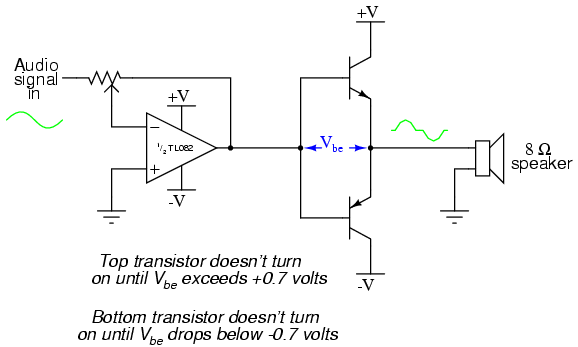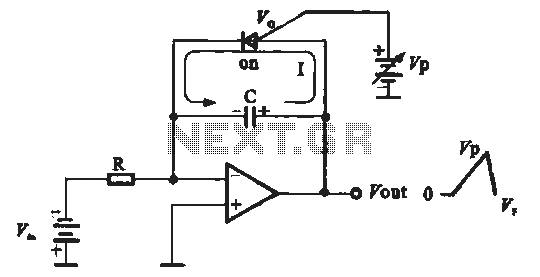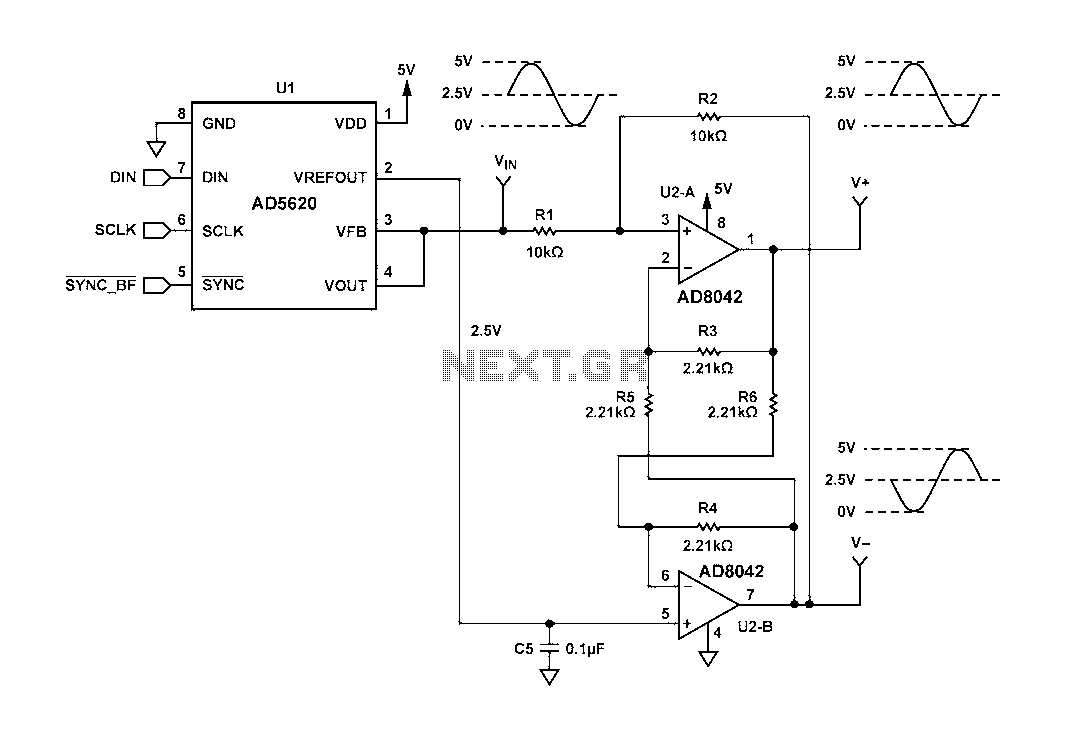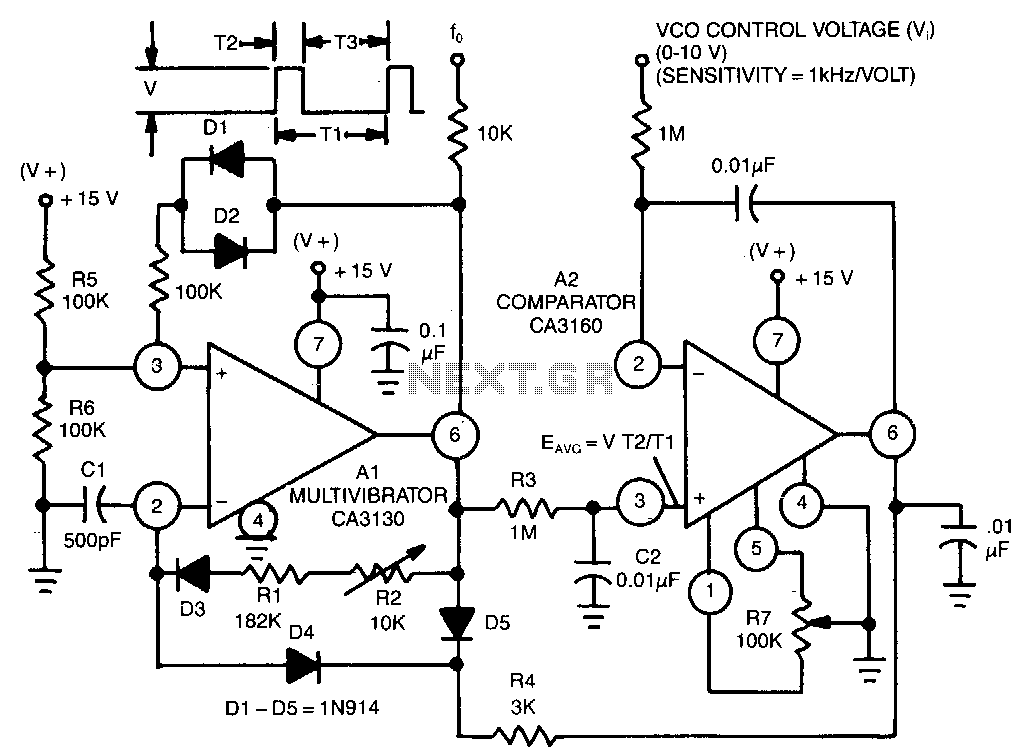
Analog Voltage Camera-Image Tracker
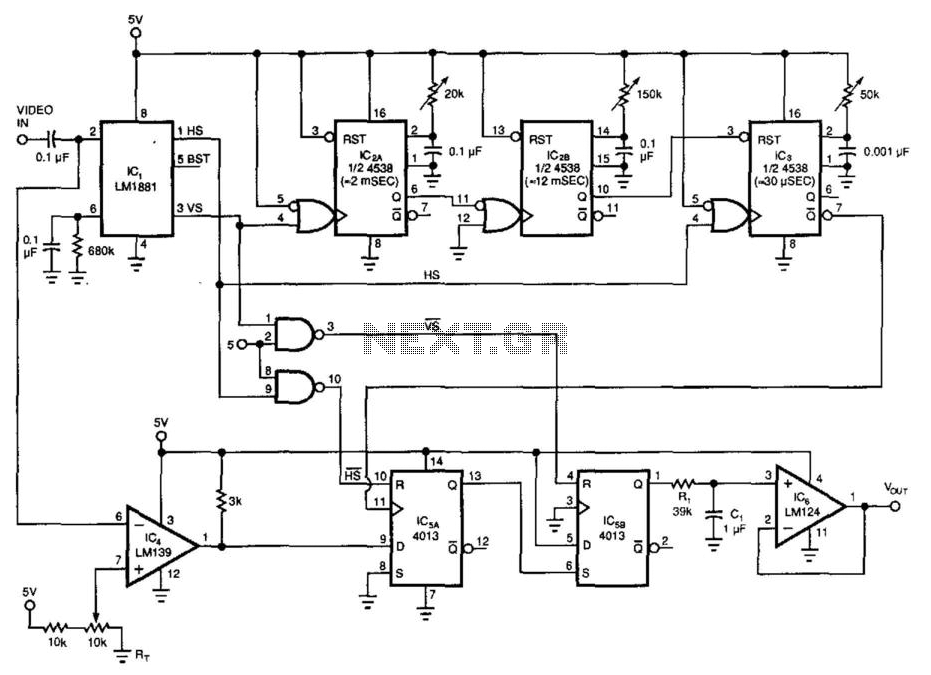
By utilizing a low-cost RS-170 camera and this circuit, a voltage that indicates the position of an object within the camera's field of view is generated. IC2A and IC2B create a valid video gate that keeps IC3 in a reset state during the internal vertical blanking to avoid misinterpretation of the UBI as black video. IC4 functions as a black level detector. The circuit checks for a black object located in the center of each video line. IC5 captures the output of the comparator and generates a square wave with a duty cycle that varies based on the detected black level in the video field. R1, C1, and IC6 serve to integrate and buffer the analog output voltage.
The circuit utilizes an RS-170 camera, which is a standard video format camera, to capture images and detect the position of objects based on their color contrast against the background. The process begins with the camera outputting a video signal that is processed by the integrated circuits (ICs) in the circuit.
IC2A and IC2B are configured to establish a valid video gate, ensuring that the downstream components only receive valid signals during the active video period. This gating is crucial because it prevents IC3 from processing erroneous signals that could occur during the vertical blanking interval, where the camera is not actively capturing image data. This mechanism avoids false readings that could compromise the accuracy of the object detection.
IC4 is designated as a black level detector. It continuously monitors the video signal for the presence of a black object, specifically checking the luminance levels in the center of each video line. The detection of a black object is determined by comparing the signal level against a predefined threshold. When a black object is identified, it triggers a response in the subsequent circuitry.
IC5 acts as a latch for the output from the comparator, which is likely integrated within IC4. This latch captures the momentary state of the black level detection and converts it into a square wave output. The duty cycle of this square wave is directly proportional to the location of the detected black level within the video frame. Thus, the width of the pulse can be interpreted to ascertain the position of the object being monitored.
The integration and buffering of the analog output voltage are accomplished by R1, C1, and IC6. R1 (a resistor) and C1 (a capacitor) form an RC network that smooths the output signal from IC5, converting the square wave into a more stable analog voltage. IC6, which is likely an operational amplifier or buffer, further stabilizes this voltage for use in downstream applications, ensuring that the output can be reliably used for further processing or control tasks.
Overall, this circuit is designed to effectively detect and track objects based on their visual characteristics, particularly focusing on the presence of black objects against varying backgrounds, making it suitable for applications in automation, robotics, and surveillance systems. By using a low-cost RS-170 camera and this circuit, a voltage that trades the position of an object in the field of view of a camera is generated. IC2A and IC2B form a valid video gate that holds IC3 in reset during the internal vertical blanking to prevent false interpretation of the UBI as black video. IC4 is a black level detector. The circuit tests for a black object in the middle of each video line. IC5 latches the comparator"s output and produces a square wave whose duty cycle depends on where the black level is detected in the video field.
Rl, CI, and IC6 integrate and buffer the analog output voltage.
The circuit utilizes an RS-170 camera, which is a standard video format camera, to capture images and detect the position of objects based on their color contrast against the background. The process begins with the camera outputting a video signal that is processed by the integrated circuits (ICs) in the circuit.
IC2A and IC2B are configured to establish a valid video gate, ensuring that the downstream components only receive valid signals during the active video period. This gating is crucial because it prevents IC3 from processing erroneous signals that could occur during the vertical blanking interval, where the camera is not actively capturing image data. This mechanism avoids false readings that could compromise the accuracy of the object detection.
IC4 is designated as a black level detector. It continuously monitors the video signal for the presence of a black object, specifically checking the luminance levels in the center of each video line. The detection of a black object is determined by comparing the signal level against a predefined threshold. When a black object is identified, it triggers a response in the subsequent circuitry.
IC5 acts as a latch for the output from the comparator, which is likely integrated within IC4. This latch captures the momentary state of the black level detection and converts it into a square wave output. The duty cycle of this square wave is directly proportional to the location of the detected black level within the video frame. Thus, the width of the pulse can be interpreted to ascertain the position of the object being monitored.
The integration and buffering of the analog output voltage are accomplished by R1, C1, and IC6. R1 (a resistor) and C1 (a capacitor) form an RC network that smooths the output signal from IC5, converting the square wave into a more stable analog voltage. IC6, which is likely an operational amplifier or buffer, further stabilizes this voltage for use in downstream applications, ensuring that the output can be reliably used for further processing or control tasks.
Overall, this circuit is designed to effectively detect and track objects based on their visual characteristics, particularly focusing on the presence of black objects against varying backgrounds, making it suitable for applications in automation, robotics, and surveillance systems. By using a low-cost RS-170 camera and this circuit, a voltage that trades the position of an object in the field of view of a camera is generated. IC2A and IC2B form a valid video gate that holds IC3 in reset during the internal vertical blanking to prevent false interpretation of the UBI as black video. IC4 is a black level detector. The circuit tests for a black object in the middle of each video line. IC5 latches the comparator"s output and produces a square wave whose duty cycle depends on where the black level is detected in the video field.
Rl, CI, and IC6 integrate and buffer the analog output voltage.
